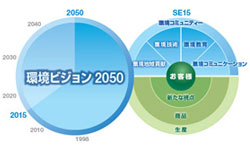環境活動の歩み

地域との共生、競争より協調、そして地球を友に
自然に恵まれた信州諏訪地方に1942年にエプソンは創業しました。「地域との共生」を礎とし、事業がグローバルに成長する中にあっても、自然環境を敬う企業風土は変わることはなく、1988年 世界に先駆けたフロンレス宣言に代表される地球規模の環境問題への取り組みへと発展します。「地域との共生」 の考えから、「競争より協調」をモットーに環境活動で得られたノウハウを広く社会とも共有してきました。経営理念に掲げる「地球を友に」、社会とともに発展する会社を目指し、これからも環境活動に取り組んでまいります。
1942~1979年
創業~ 地域周辺の汚染防止
諏訪湖を汚さないよう事業所から発生する排水処理に取り組みました。また、公害問題が社会的にクローズアップされた1970年代には、法律や条例の規制値よりも厳しい社内環境自主基準を設定し、汚染防止の徹底を図りました。

1980~1989年
1983 省エネルギー活動
1980年から、削減目標の設定・構内省エネパトロール・省エネ機器の導入などによる、省エネルギー活動を推進してきました。1983年には、松塩作業所(現在の広丘事業所6号館)工場内の照明器具をマイコン内蔵のシステムで制御し、大幅な省エネを図ったことが認められ、(一社)照明学会の「照明普及賞」を受賞しました。


1988 フロンレス宣言
オゾン層破壊物質であるフロンに対して、世界に先駆けてフロンレスを宣言。この年をエプソンの「環境元年」としグループ一丸となってフロンレス活動をスタートさせ、1992年に日本国内、翌年1993年には全世界で洗浄用特定フロンの全廃を達成しました。

1990~1999年
1991 開かれた洗浄センター
フロンレスの技術をいち早く確立したエプソンは、協力会社のフロン全廃についても積極的に支援しました。地域の協力会社でもフロン全廃を達成できるよう、フロンレス装置の共有化を狙ってつくられたもので、各社は洗浄の工程を島内事業所に設けられた洗浄センターで行いました。

1992 フロン全廃活動の評価
エプソンのフロンレス活動が評価され、米国環境保護庁(EPA)より「成層圏オゾン層保護賞(企業賞)」を受賞。以降、6年連続で企業賞・個人賞を受賞しています。
中村恒也 会長(当時)のコメント
「フロンによってオゾン層が破壊されることが判明し、当社は産業界においていち早くフロン全廃に向けて取り組んだわけですが、当初はあまり大きな決断をしたとは思っていませんでした。しかしながら、今回の受賞によって、改めて大きなことを成し遂げた、と実感しています。」

1993 世界で広がる地域活動
「地域との共生」は世界各地にも浸透し、地域に根差したボランティア活動が展開されました。Epson America, Inc.(EAI/米国)では、社員による海岸の清掃活動が、この年受賞したカリフォルニア総合廃棄物管理委員会の「廃棄物削減賞」の評価にもつながっています。

1998 第二の環境元年
フロンレス活動を開始してから10年が経過した1998年を「第二の環境元年」と位置づけ、多様な環境問題に総合的に取り組むべく「環境総合施策」を策定し、6つの専門委員会を立ち上げ活動を開始しました。
・環境商品委員会
・省エネルギー委員会
・ゼロエミッション委員会
・商品リサイクル委員会
・化学物質管理委員会
・グリーン購入委員会

1999 環境報告書の発行
エプソンの環境活動を広く公開し、社会の皆様のご意見を活動に反映することを目的に、「環境報告書」を1999年より年次報告として発行しています。2003年からは環境活動に社会性を加えた「サステナビリティレポート」として発行しています。

2000~2009年
2000 省エネパトロール活動
これまで公開していた省エネ技術を現場で生かしたいという声を受け、2000年に地域の企業と共に「諏訪地域省エネパトロール隊」を立ち上げ、諏訪地域の企業を対象に、省エネ診断と改善のアドバイスをする活動を開始しました。2005年には活動の成果が長野県に認められ、長野県全域に拡大し「信州省エネパトロール隊」を結成、さらに2010年からは、台湾で同様の活動が展開されています。

2000 植林活動の支援
熱帯雨林の減少が著しい東南アジアにおいて、プリンターの製造拠点のあるインドネシアを支援するべく、インドネシアのカリマンタン島で「エプソンの森」づくりに取り組みました。(公財)国際緑化推進センターの協力を得て、インドネシア政府と連携し、約300ヘクタールの植林活動と維持を2000年から8年間行いました。また、この植林活動では、樹木と農作物を混植することで、衰退した森の再生と、地域住民の生活向上の2つの効果をもたらすアグロフォレストリー方式を採用しました。

2001 ISO14001認証取得
環境活動を継続的かつ効果的に取り組むことを目的とし、国際規格ISO14001の取得にいち早く取り組みました。
1995年にEpson Telford Ltd. (ETL/英国)が英国の環境管理規格BS7750認証(ISO14001のもととなった規格)を取得して以降、2001年には国内外の主要な製造・非製造拠点すべてでISO14001認証取得が完了しました。

2001 エプソンエコロジーラベル
環境配慮型商品の創出と、お客様への環境情報の公開を目的として、2000年に自己宣言型環境ラベル「エプソンエコロジーラベル」制度の運用を開始しました。2001年にページプリンター「LP-9400/ EPL-N7000」が第1号適合商品として発売されました。

2003 生産材グリーン購入活動
商品を構成する一つ一つの部品・原材料の含有化学物質について、全世界同基準で保証されたものを調達することを目的に、「セイコーエプソングループ生産材グリーン購入基準書」を制定し、サプライチェーン全体での製品含有化学物質保証活動を開始しました。

2003 ゼロエミッション活動
事業活動から発生するすべての排出物の再資源化(レベル1)と総量の削減(レベル2)に1997年から取り組んできました。2003年には、全世界の拠点でレベル1を達成しました。レベル1達成後は、排出物そのものを減らすとともにより高いレベルの再資源化に取り組んでいます。

2008 環境ビジョン2050
深刻化する地球温暖化問題に抜本的に対応するため、長期的な視点に基づく既成概念を超えた長期ビジョンとして、エプソンは環境ビジョン2050を策定しました。

2010~2019年
2010 SE15中期環境活動方針
環境ビジョン2050を達成するための初めのマイルストーンとして、2015年の目指す姿を、SE15中期環境活動方針として策定しました。

2010 新たな視点
エプソンの革新的な商品・技術を通してお客様の環境負荷を低減する「新たな視点」での商品として、デジタルラベル印刷機SurePress L-4033Aを発売しました。従来のアナログ印刷機で発生していたお客様のもとでの環境負荷を、エプソンのマイクロピエゾテクノロジーにより革新することで大幅に低減することを実現しています。

2010 大容量インクタンクシステム
インドネシアでの大容量インクタンクシステム搭載プリンターの発売を皮切りに、その後新興国を中心に約150の国・地域へと拡大。従来のカートリッジ交換の概念を覆す大容量ボトルでのインク補充によって、資源消費を低減できる優れた環境性能を発揮しています。

2012 商品の小型化追求
商品の基本性能をよりエコにする取り組みとして、「おきたい場所における」プリンターを目指して徹底的な小型化を追求したプリンターを発売しました。プリンターメカニズムの小型化や新型プリントヘッドとインクカートリッジの薄型化により、商品の奥行き、幅、高さそれぞれにコンパクト設計を施すことで、前機種(EP-804Aシリーズ)と比べて大幅な小型化を達成しています。

2014 オフィスのプリンティングを変える
レーザーから、インクジェットへ。進化したエプソンのインクジェット技術が、オフィスのプリンティングを変えていきます。
大容量インクパックシステムを搭載したビジネスインクジェットプリンターは、消耗品の交換頻度が圧倒的に少なく省資源で、作業負荷(交換、発注、在庫管理、物流負荷など)も抑えられます。また、印刷時に熱を使わず、レーザープリンターに比べ低消費電力です。

2016 PaperLab(ペーパーラボ)発売
紙のサイクルを変える技術を開発。使用済みの紙に新たな価値を与え、循環型オフィスを創出していきます。オフィス製紙機「PaperLab(ペーパーラボ)」は、2016年に日本で発売しました。エプソン独創の「Dry Fiber Technology(ドライファイバーテクノロジー)」により、オフィス内での小さなサイクルで、機密文書の完全抹消と、貴重な資源である水を使わない*1紙の再生を可能にしました。
*1 機器内の湿度を保つために少量の水を使用します

2016 長期ビジョン「Epson 25」発表
エプソンの「省・小・精の技術」が生み出す価値で4つのイノベーションを起こし、環境側面では、お客様の業務プロセス全体を含め、エプソン商品・サービスで環境負荷低減を図ることを目指しています。

2018 「環境ビジョン2050」改定
社内外の環境変化を基に、社会要求を反映した、持続可能な社会を目指すビジョンへ改定しました。脱炭素化・資源循環・SDGsなど社会課題に対し、エプソンならではの環境価値を創出する意思を明確に示しました。

2018 科学的な根拠に基づく温室効果ガス削減目標
2025年までの温室効果ガス(GHG)削減目標が「パリ協定」を達成するための科学的な根拠に基づいた目標であると認められ、「SBTイニシアチブ」から承認を取得しました。

2019 グリーンボンド発行
持続可能な社会の実現に向けたプロジェクトに要する資金をグリーンボンド*1で調達するため、グリーンボンド・フレームワークを策定しました。Epson 25実現に向けて、環境の取り組みを前進させるため、環境に配慮した資金調達を積極的に活用します。
*1環境分野への取り組みに特化した資金を調達するために発行される債券

2020年~
2020 大容量インクタンク搭載プリンター5,000万台達成
2010年10月インドネシアでの大容量インクタンク搭載インクジェットプリンター発売以降、販売エリアを約170の国と地域へ拡大し、世界累積販売台数が5,000万台を達成しました。インクカートリッジモデルと比べ、消耗品主原料であるプラスチックなどの使用削減に貢献しています。

2021 「環境ビジョン 2050」改定
長期ビジョン『Epson 25 Renewed』策定の一環として、エプソンが将来にわたって追求するありたい姿として設定した「持続可能でこころ豊かな社会の実現」を目指すための具体的な達成目標を設定するなど、さらなる改定を行いました。エプソンは、2050年に「カーボンマイナス」と「地下資源*1消費ゼロ」を目指します。
*1原油、金属などの枯渇性資源

2021 「Epson 25 Renewed」発表
「省・小・精の技術」とデジタル技術で人・モノ・情報がつながる、持続可能でこころ豊かな社会を共創することをステートメントとした長期ビジョンを発表。この取り組みの中で重要となるのは、「環境」、「DX」、「共創」の3つで、「環境」への貢献に重点を置きます。そのうえで、イノベーション実現のために、デジタル技術を活用し、多くのパートナーとの共創に取り組んでいきます。

2021 国内拠点の再生可能エネルギー化
2050年のカーボンマイナスの実現に向けて、2023年までに世界に展開するエプソングループ全拠点の使用電力の再生可能エネルギー化を目指しています。2021年11月には、国内製造業で初めて*1、国内拠点における使用電力のすべてを再生可能エネルギーに転換しました。
*1日本のRE100加盟企業の内。2021年10月27日時点(エプソン調べ)

(日本)
2023 WWFとのパートナーシップ締約
世界的な環境保全団体である世界自然保護基金(WWF)と3年間のインターナショナル・コーポレート・パートナーシップを締約しました。パートナーシップは「持続可能な事業活動の実現」「社会への環境コミュニケーション」「WWF自然保護プロジェクトへの資金支援」の3分野を含む協働を行います。エプソンは、寄付を通じてWWFが世界各地で行う森林保全活動を支援します。

2023 グローバル全拠点の使用電力を100%再生可能エネルギー化
再生可能エネルギー化の宣言からわずか2年10か月という短期間で、2023年12月に全拠点の100%転換を完了しました。この取り組みは、国内製造業として初の事例*1です。各地域にて最適な自然エネルギーを継続的に活用していくことで、自社の目標達成のみならず社会全体に対して理解や共感を広げ、再エネの普及が進みやすい社会環境の醸成にも貢献します。
*1日本のRE100加盟企業の内。2024年1月9日時点(エプソン調べ)

(シンガポール)



